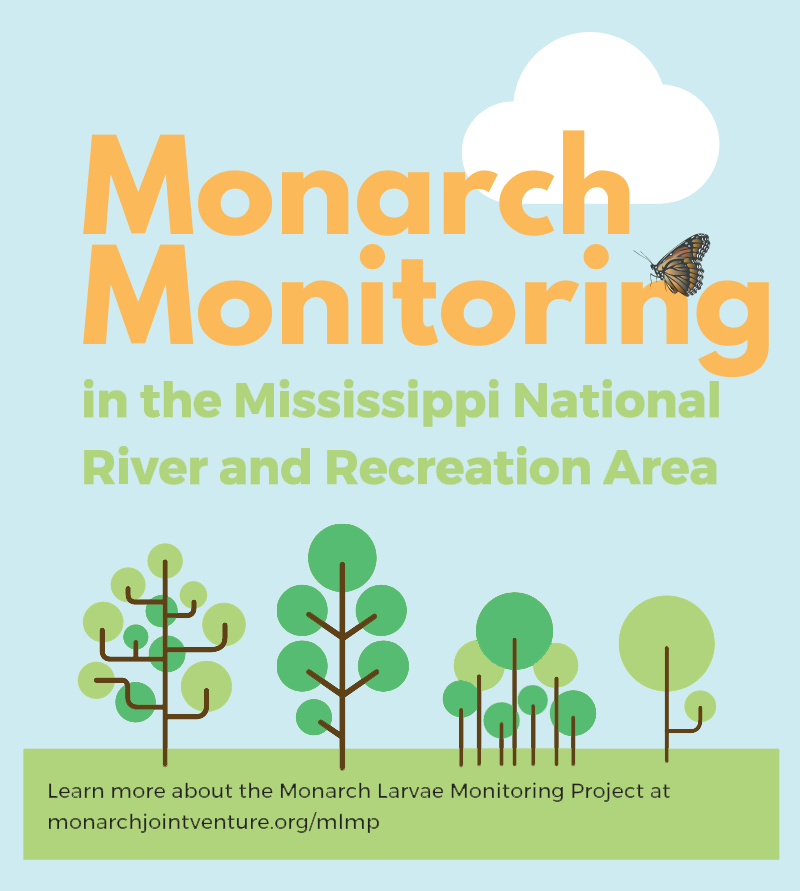What the monarch butterfly reveals about volunteers
By Erika Van Krevelen, Community Volunteer Ambassador, Mississippi National River and Recreation Area
Much like a parent watching their kid head off to college, fall is a bittersweet time where we say “see you later” to monarch butterflies as they make their way south to spend the winter roosting in the oyamel fir forests of Mexico. Their stay in Minnesota is short-lived—lasting only about as long as the summer—so a sighting of these beautiful insects is something to be treasured. Few people know this better than monarch monitoring volunteers, who get out into the park to conduct weekly surveys of monarch and milkweed density as part of the Monarch Larva Monitoring Program.
The Monarch Larva Monitoring Project (MLMP) is a community science project to better understand monarch population dynamics in North America by studying monarch and milkweed density. The Mississippi National River and Recreation Area (MISS) has participated in the MLMP since 2015 and continues to expand the program across the park’s 72-mile stretch. In 2021, monitoring locations included sites at Coldwater Spring (Mni Owe Sni), Upper Landing Park, Mill Ruins Park, and North Mississippi Regional Park. The data gathered across these sites contribute to scientific research that examines changes and trends in monarch populations. The data can also be used locally to inform management decisions, improve monarch habitat, and inspire monarch conservation in our communities.
Across the state of Minnesota, 23,940 monarch observations were made by community scientists and uploaded to the MLMP database in 2021. Over a fourth of those observations came from volunteers with the Mississippi National River and Recreation Area, and their combined 130 hours of service has a value of more than $3,700! But more than its monetary value, volunteer service carries intrinsic value that cannot be quantified so easily. Our volunteers become educators in the field, sharing their knowledge and observations with the curious passerby. They are champions for monarch conservation, making contributions to the scientific understanding of a species increasingly impacted by habitat loss. They pump energy and enthusiasm into the project, offer ideas and insights, and provide unique perspectives. These contributions cannot have a dollar sign attached to them. As Albert Einstein put it, “Not everything that counts can be counted, and not everything that can be counted counts.”
MLMP and other community science projects underscore the impact that a collective effort can have. Without the thousands of volunteers across North America scanning the landscape and sky for monarchs, the large-scale data collection needed to identify monarch population trends across time and space simply wouldn’t be feasible. There are other community science efforts that aim to better understand the monarch butterfly. Journey North tracks monarch migration in North America. Check out their live migration map, generated from community-reported monarch observations. As of late-October 2021, monarchs have been sighted as far south as central Mexico. Perhaps some of these monarchs are the same ones we saw as caterpillars on milkweed leaves at North Mississippi Regional Park, or the butterflies we watched sipping nectar from a blazing star at Coldwater Spring (Mni Owe Sni).
While monarch monitoring has wrapped up for the 2021 season, it will be back late spring of 2022, as the grandchildren, great-grandchildren, and great-great-grandchildren of the monarchs observed this past summer make their journey north. If you love the natural world and the excitement of discovery, or you want to be part of a country-spanning research project, consider joining us next year to observe the next generations of monarchs as they begin again to grace our gardens. Sign-up to receive our volunteer newsletter to stay informed of future opportunities to get involved.




